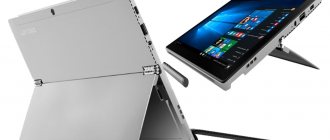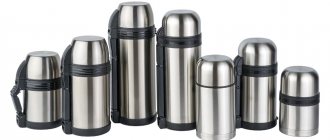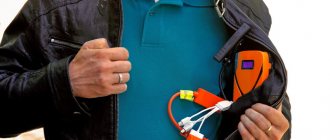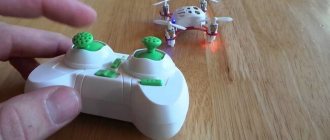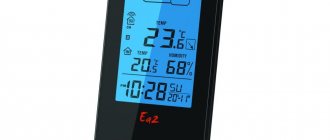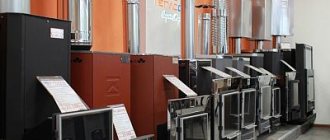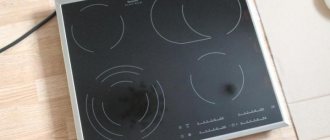Types and types of dosimeters
The dosimeter is designed to ensure the safety of human health. It determines the level of radiation. There are 2 types - professional and household. The first is used at nuclear power plants, factories, and banks. Household products are purchased for use at home and are divided into three types:
- individual;
- pocket;
- portable.
An individual dosimeter is a device the size of a key fob. If the radiation exceeds the norm, it informs the person with a sound or vibration signal. The model is very simple, without a display. Convenient to carry in your pocket. There are several types of personal dosimeter - according to detection method and purpose.
Full information can be obtained when connecting devices to a smartphone
Important! An individual dosimeter measures neutron, photon, beta or gamma radiation.
Pocket models weigh no more than 100 g. They have an LCD display and easily fit in your pocket. They are produced in the form of multifunctional devices and original wristwatches. The scope of application of the device is small. You can diagnose materials and products. Pocket dosimeters can only detect high levels of radiation. They synchronize with gadgets.
It is possible to set limit values
A portable dosimeter registers gamma radiation. It displays information on the display and signals high radiation levels with sound, vibration or light. Often portable models combine a dosimeter and a radiometer. Compact, no need to connect to specialized equipment to obtain all the information. Any gadget or personal computer is enough.
4 detectors are installed, which increases the accuracy and scanning area
There are also non-threshold and threshold dosimeters. The latter are more useful because they show digital background values over a wide range. Threshold ones are more reliable, but non-threshold ones answer pressing questions about the degree of danger.
All models are divided into indicators, signaling devices, spectrometers, search engines and meters. Indicators are the least sensitive; alarms notify with a sound signal about a sharp change in background radiation; spectrometers determine the type of isotope; search engines have the lowest measurement accuracy; meters are more sensitive and equipped with advanced sensors.
Varieties
The counter is the main component that is used to measure radiation particles in the air. There are different types of instruments, some of which are aimed primarily at the combined radiation of gamma and beta particles. For example, a Geiger counter is designed to detect beta and alpha radiation. Gas-discharge devices are used to detect gamma and beta radiation, but such devices usually detect radiation only above normal.
Miniature devices, whose principle is based on TLD, are distinguished by the fact that they record only X-ray radiation, where the accumulation of particles is minimal. The characteristics of the dosimeter, which is based on scintillation crystals, are aimed only at finding the radioactive background, consisting of gamma and beta radiation.
These devices usually take up quite a bit of space and fit into a pocket, making them completely mobile. There are also pin diodes that look like a regular phone add-on. Such a device is considered the least efficient, since it can only show critical radiation.
Choosing the right dosimeter
Special devices will help reduce the negative impact of nitrates, impurities in water, carbon dioxide, radiation and electromagnetic waves. For example, a dosimeter.
If you are thinking about which model to choose, you should know what criteria you need to pay attention to:
- Purpose - for industrial or household purposes.
- Catching block. It is built into the body of the product, but sometimes can be installed separately. The latter are used in professional dosimeters.
- Measurement time. For active movements, a device that works faster and provides information within 20-40 seconds is suitable. This model will cost more.
- Accuracy of measurements. The best are professional devices; they measure radiation levels quickly and accurately. The cost is relatively high. Of the household ones, the threshold one is better. He gives specific data.
- The upper measurement value must be no lower than 10,000 µR/h.
- Number of sensors. It's good if the model contains 2 or more. This will make it possible to measure different types of radiation.
Attention! The model with pin diodes turned out to be useless in application. It is not recommended to buy it.
Some models are equipped with built-in memory, dust and moisture protection, battery saving mode and Bluetooth. This is an additional functionality that does not affect the operation of the radiation dosimeter, but greatly simplifies the use of the device.
Dosimeter and its functions
A dosimeter is a device for measuring radiation (radioactive radiation) in a specific location or sample. Measurements can be taken indoors or outdoors. Today, there are more and more sources of radiation; they can be products purchased at the market or various items, including those brought from abroad.
That is why the demand for household dosimeters, which are accessible to ordinary people and do not cause difficulties in use, is growing. Before purchasing, many are concerned about the question of how to choose the right radiation dosimeter. And in this article we will try to figure out which devices are most suitable for household measurements, the most reliable and provide the most reliable information.
So, any buyer should always pay attention to the following points:
- Convenience and ease of use;
- Efficiency of sensors used in equipment;
- The ability to show reliable measurement data;
- Functionality and availability of additional features.
Radiation sensors and their types
The main component of any dosimeter is considered to be a radioactivity sensor , which helps to carry out operational monitoring of the radiation situation. The speed of data acquisition and the magnitude of the error depend on the quality and efficiency of the radiation sensor in the dosimeter. In all cases, when the question arises about which dosimeter to choose, you must first of all pay attention to the radiation sensor , which is included in the proposed equipment.
Radiation sensors, according to their design and purpose, are divided into two types:
- Cylindrical, which resemble an oblong balloon tube in the form of a cylinder;
- End-mounted, having a round or rectangular ionization chamber and a significant working end surface.
Sensors can be designed to measure a separate radiation spectrum (alpha, beta, gamma) or their different combinations, which depends on the tasks. The first type of dosimeter, with a cylindrical sensor, is suitable for recording and detecting gamma and beta radiation. This type of radiation has a sufficient amount of energy and high penetrating power, so the ionization chamber of the sensor is able to register them. It is for determining this type of radiation that the most common SBM-20 sensors are suitable, as well as their modification SBM-10 and others. The SBM-20 sensor is characterized by the following technical characteristics:
- The working area of the sensitive element with a total area of 8 cm²;
- With radiation sensitivity for gamma radiation 60 ÷ 75 imp/µR;
- The device's own background is no more than 1 pulse/s.
Also, the SBM-20 sensor can be used exclusively for detecting gamma rays, but to do this, a screen made of steel or lead must be installed on top of it, which eliminates the possibility of detecting alpha and beta radiation. The SBM-20 sensor is not demanding in terms of operating conditions and is successfully used in professional equipment.
To more effectively determine gamma radiation, end sensors are used, in the input window of which metal filters are installed, which cut off alpha-beta radiation and increase the cathode area. Such designs make it possible to more accurately determine the level of radiation contamination by gamma radiation. These include sensors Beta-1M, Beta-2M, etc.
Let's take a closer look at the Beta-2M sensor, which has a round-shaped working window with an area of about 14 cm². Radiation sensitivity is about 240 pulses/μR. This sensor is distinguished by rather low intrinsic background values, which are no more than 1 pulse/s. This became possible due to the thick walls of the chamber. The Beta-2 sensor allows you to detect alpha, beta and gamma radiation.
You can read more about radiation sensors in our article - “Geiger-Muller counter: history of creation, principles of operation and purpose .
Dosimeter capabilities. What can they measure?
Modern dosimeters allow you to determine and measure the following:
- Level of contamination with radioactive substances in residential premises and various surfaces;
- The total amount of radioactive substances in products;
- External gamma background level.
The main types of ionizing radiation include alpha, beta, gamma and x-rays. In order to analyze measurements and determine the level of radiation contamination, you need to know what dose rate is.
Dose rate is the dose delivered over a certain period of time. The larger it is, the faster the radiation level increases. In parallel with this, the concept of natural background is used, which shows the radiation dose rate in a certain place created by natural sources. The natural background is different everywhere, depending on the terrain.
A radiation level of up to 50 micro-roentgens per hour (0.5 microsieverts per hour) is considered safe; as for external irradiation of the human body, the most optimal level is up to 30 micro-roentgens per hour (0.3 microsieverts per hour). CPM measurement mode . This indicator evaluates the intensity of radiation by directly counting the number of particles that the sensor detects. Using SRM, you can most quickly assess the radiation contamination of an object.
It is important to remember such a concept as accumulated radiation dose. If a person accumulates about 3-4 mSv/g per year, then this dose is considered average and safe. This cannot be avoided, since in nature there is always some background radiation. The available range in household dosimeters is quite enough to determine the maximum permissible dose of radiation, and if the device detects this, then you need to either leave the place or eliminate the object - the source of radiation.
The best manufacturers of radiation dosimeters
There are quite a lot of manufacturing companies. In order not to make a mistake in your choice and not to acquire a counterfeit device, you should always check the authenticity of the product. There is one way to do this: ask the seller for all the documentation and certificates.
There are many competitors on the global market, but by studying reviews and products, experts managed to select the best manufacturers:
- Anmez;
- Radex;
- Soeks;
They offer good quality models. They sell both professional and household devices.
Leading manufacturers equip household models with additional functionality - a water quality analyzer, a nitrate meter. This makes the model more functional and in demand.
Rating of the best professional radiation dosimeters
Having compared the 10 top models of radiation dosimeters, we can highlight the best 5 devices. Selected devices quickly analyze the information received and can work for a long time without fear of exposure to the atmosphere.
RADEX MKS-1009
Detects beta and gamma radiation. The radiation dosimeter runs on 1 battery. The user receives all the necessary information in Russian, which is displayed on a backlit screen.
The device provides accurate data and alerts about high levels of radiation. The model instantly assesses dangerous background radiation.
Operates continuously for 950 hours, that is, 40 days on 1 battery
DRGB-01 ECO-1
The radiation dosimeter has three measurement modes - gamma radiation, beta particles and specific radioactivity based on the flux density of beta particles. The portable device has a sensitive surface and a thin mica window. When gamma ray registration is required, the counter window is closed with a special screen.
Includes instruction manual, AC adapter, inspection certificate and storage bag.
Battery powered
Quantum
The innovative model of the SOEKS company is the best device among the dosimeter line. The measurement results appear in 10 seconds. It runs on a battery and can be recharged from any device - PC, laptop.
Advice! You can connect the device to a computer to obtain more detailed information.
There is a built-in calendar, clock and alarm clock.
The peculiarity of Quantum from SOEKS is the presence of 2 sensors and high measurement accuracy. The radiation dosimeter has programmed norms and thresholds for dangerous levels. Thanks to this, there is no need to remember them.
MKS-05 TERRA-P plus
The model measures the level of radiation and assesses the contamination of a living space. The professional device has a backlit digital indicator. Dimensions are small, weight is low.
Measures gamma background level and accumulated dosage, evaluates beta pollution
Operates continuously for 6000 hours, measures radiation levels every 5-10 seconds. Supplied complete with AA batteries and instruction manual.
RADIASKAN-701A
The professional model measures radiation with high accuracy. The improved model contains curtains on the back of the case, by opening which you can get more accurate information.
Color display
The sensitivity of the sensor is 2 times higher than usual ones used in cheap dosimeters for measuring radiation.
Rating of the best Rating of the best electronic dosimeters for 2021
The best and most common instruments for measuring radiation are electronic - a huge category in which there is room for primitive and more complex designs. The main advantage of such dosimeters is their high measurement accuracy. In the question of which device is better to buy, there are several nuances: the degree of novelty and, accordingly, the cost. The best models, according to buyers, include the production of goods from companies:
- "Smart Geiger";
- "Soex";
- FirstSensor AG;
- "i4Technology".
Model "FSG-001" from
Purpose: to measure radiation levels in everyday life.
The personal device is connected to the phone via a headphone jack. The dosimeter receives power from the smartphone. The gadget itself acts as a control unit for the display. This device is used by people who care about their health.
Appearance of the dosimeter model “FSG-001” from
Specifications:
| Size (centimeters): | 4,7/1/3 |
| Weight with packaging: | 300 grams |
| Platform Compatibility: | Android, iOS |
| Material: | aluminum |
| Manufacturer country: | South Korea |
| By price: | 3500 rubles |
Advantages:
- Miniature;
- Easy to use;
- Does not require separate nutrition;
- Build quality
Flaws:
- Not identified.
Model "112" from
Purpose: to assess the radiation safety of objects and the environment.
Externally, the device resembles an electronic thermometer. The case is plastic with two control buttons. Used outdoors and indoors. It will be a good option for a gift to loved ones. Powered by two coin-type batteries. When the measurement is completed, the light comes on. During operation, the dosimeter creates a characteristic sound (buzzing). The display is monochrome.
Device in operation, model “112” from
Specifications:
| Working temperature: | -10-+50 degrees |
| Net weight: | 30 grams |
| Radioactive background level: | 0-999 µSv/h |
| Continuous operation: | 100 hours |
| Maximum error: | +/-15% |
| Excess warning: | from 0.4 μSv/h |
| Number of batteries: | 2 pcs. LR44 |
| Average cost: | 4600 rubles |
Advantages:
- Compact;
- High measurement accuracy;
- Speed of readings;
- A universal device (for everything).
Flaws:
- Not identified.
Model "Pocket Geiger" from
Purpose: for measuring radiation indoors and outdoors.
A portable device that can work in conjunction with a computer, tablet or phone. It can be used as a household individual device or as a device in scientific experiments. Thanks to modern technologies, the dosimeter has good potential. The device itself is small, in a white plastic case with the necessary connectors and one button. The standard counter, like most products for this purpose (Geiger-Muller), has been replaced with a gamma radiation photodiode. Thanks to its hardware and application, the device independently evaluates the error, which will allow you to objectively evaluate the measurements.
Model "Pocket Geiger" from and connection cable
Specifications:
| Size (centimeters): | 6,1/3,4/1,2 |
| Net weight: | 80 grams |
| Fits: | Windows 7 and 8, Android version 4.1+ |
| Measuring range: | 0.05-100 µSv/h |
| Analysis time: | 2 minutes |
| Working temperature: | 0-40 degrees |
| Manufacturer country: | Germany |
| Average price: | 5500 rubles |
Advantages:
- Compact;
- Ease of use;
- Low cost;
- Wide scope of application;
- With autonomous error estimation function.
Flaws:
- Works only in positive temperatures.
Model "EcoLifePro1" from
Purpose: to determine the level of radiation and accumulated dose.
A push-button device with a large display in a black plastic case looks like a mobile phone, although the settings and charging are almost identical to the gadget.
Thanks to a professional-grade radiation counter and a double-checking algorithm for the results obtained, it ensures high accuracy of measurements. When the reading exceeds the permissible value, the dosimeter gives a sound signal. With it you can monitor your health, taking it with you to shops, the market, etc. The installation is equipped with a Russian-language interface, and for convenience it also supports the English version.
Among other things, the device has a timer and thermometer, which makes it more useful for everyday activities. Any power can be used: two AA batteries, a battery that is charged using a personal computer via a cable or using a power cord. One charge is enough for 3 days.
Model "EcoLifePro1" from, dosimeter design
Specifications:
| Size (centimeters): | 10,5/5,8/1,85 |
| Net weight: | 110 grams |
| Error: | +/-25 percent |
| Registered radiation power (MeV): | 0.05-3 – gamma; |
| from 5 – beta | |
| Radiation level and accumulated dose (μSv/h or μR/h): | 0-1000/0-100000 |
| Nutrition; | AAA battery or 2 AA batteries |
| Continuity of work: | 72 hours |
| Time to take measurements: | about 10 seconds |
| Manufacturer country: | Russia |
| What is the price: | 6800 rubles |
Advantages:
- Intuitive controls;
- Design;
- High precision;
- Battery charge indicator;
- Any recharging method;
- Value for money;
- Two units of measurement;
- Measuring the background of any products and things.
Flaws:
- Not identified.
Rating of the best household radiation dosimeters
The demand for household dosimeters is high in industrial cities. Using devices with sufficient functionality, you can detect dangerous products and identify bad water.
A review of radiation dosimeters will allow you to choose the most optimal and suitable option.
Greentest Eco 5, KIT FB0136
The model combines three functions - testing for nitrates, measuring water hardness and monitoring radiation in a residential area or outdoors. Considered the best radiation dosimeter of 2021 among household models. This device is a pocket mini-laboratory, with which you can find out the level of nitrates or radiation in a few seconds.
Made in China
Soex Ecovisor F4
The most functional device that combines 4 functions at once. The model measures the level of background radiation. The ability to measure nitric acid salts in vegetables and fruits, determine the quality of drinking liquid and search for areas with an increased number of electromagnetic waves is provided.
The device works quickly. To find out the quality of the products, just select it from the list provided and plug the device inside. The standards for the amount of nitrates are already in the device’s memory.
Measurement occurs at several points at once, which significantly increases accuracy
DO-RA VDR-IRQ1801-w
The gadget of this line is designed to indicate ionizing radiation at analysis sites. The results are immediately displayed; you can check the weekly total when connected to a computer.
Generates a graph of the state of the device owner’s organs depending on the received radiation dose
Haak Elektronik SMG-2
Measures radiation levels in 20 seconds. The display is color, there is no built-in Bluetooth. It is not necessary to follow the readings. You can set a sound alarm.
Dimensions are small. Convenient to carry in your purse
SOEKS (Soeks) Ecovisor F3
Using this environmental monitoring device, you can determine not only the level of radiation, but also the amount of nitrates contained in vegetables and fruits. The model is made of high-quality matte plastic, the side elements are rubberized.
The display is liquid crystal, touch type. Easy to use.
Important! The device is controlled using buttons, which are also designed to adjust the brightness level, change the time and date.
The device is expensive.
The dimensions of the device are small, but it is inconvenient to carry in your pocket. The kit includes a probe for checking the calculations in the products.
How to choose an individual dosimeter
Let us dwell in more detail on the principles of selection and operation of individual dosimeters that can be used in everyday life.
Household dosimeters are convenient for use for non-professional purposes. They are usually distinguished by their compact size, ergonomic design and relatively low cost. Such devices are predominantly direct-indicating (information about the radiation level is provided immediately on the display; there is no need to use additional special equipment to decipher the received data). It is worth noting that the devices show the state of the environment and objects without taking into account the amount of radiation previously absorbed by a person.
Personal dosimeters record , as a rule, exclusively beta and/or gamma rays . This is explained by the fact that there is no need to register alpha rays ( alpha particles are a stream of helium atom nuclei, which in biological tissues penetrate to a depth of only 0.1 mm and can be delayed even by a piece of paper . They pose a serious danger only if they enter the body ). A beta particle (electron flow) penetrates to a depth of 1-2 cm in biological tissues . Gamma radiation (a flow of gamma energy quanta - photons) passes through the human body unhindered . In view of this, the last two types of radiation are of interest for dosimetry, because can have quite adverse effects on humans.
When choosing a dosimeter, you should pay attention to the following details:
- a type of detection unit (gas-discharge counter or counter with a scintillation crystal). The most widely used gas-discharge counter design is the Geiger-Muller counter . This is what is most often used in household dosimeters. Scintillation crystals in the detection unit are much more accurate, but the devices containing them are large and expensive;
- The measurement time of most instruments ranges from 3 to 60 seconds . The preparation time for measurement can reach about 4 minutes. If fast operation is necessary, preference should be given to quick-reading dosimeters;
- range of measured values (its smallest and largest permissible value);
- degree of error . If its indicator is high, unreliable information is possible when working in difficult conditions (frost, high humidity);
- presence of a sound indicator ;
- dimensions;
- price.
When choosing a device for household needs, you should not strive for its versatility. The price of household dosimeters ranges from 5,000 to 20,000 thousand rubles . If you clearly understand for what purpose you need this device , then you can save a lot on its purchase. The company that has received the most recommendations for the sale of devices has a history dating back to 1990. Employees of MEPhI (Moscow Engineering Physics Institute) registered the trademark “Radex”, which has become a globally respected brand of radiation monitoring technology.
Most personal dosimeters are easy to operate and use. The classic model of the radioactivity indicator “RADEX RD1503+” is equipped with a Geiger-Muller counter, the information from which is processed by special algorithms of the built-in program. The registration of each radioactive particle in this model is accompanied by a sound signal that increases as the radiation level increases. The measurement time is 40 seconds. Recommended cost – 5200 rubles.
The RADEX RD1008 radiation dosimeter is based on the use of two Geiger-Muller counters. This design solution allows you to increase the response time, bringing the measurement time to 10 seconds. In addition to assessing the general radiation background of the environment, it allows us to approximately measure the level of radiation contamination of food products. The degree of error of the device is 2 times lower compared to its analogues. The operating time without recharging reaches 950 hours. Retail price – 17900 rubles.
One of the most compact models on the dosimeter market, RADEX RD1212-VT, is distinguished by its high functionality. The measurement time also varies within 10 seconds. It is possible to select several notification options (sound, visual indicators, vibration). The advantage is the availability of wireless Bluetooth connection. Thus, it is possible to remotely save measured data on user devices.
All models measure radiation dose in µSv/h (microsievert per hour).
The above models of dosimeters have the most favorable price/quality ratio and, at the moment, have no competitors on the Russian market.
Although it is worth noting that some of the capabilities of the devices may be overestimated by the manufacturer. Thus, the reality of measuring the level of ionizing radiation in food products, unless they are sprinkled with radioactive dust, is highly questionable.
But, for example, it is possible and necessary to reliably check the safety of building materials using such devices.
General principles of working with a dosimeter
Having chosen a dosimeter, it is necessary to correctly measure the ambient background. The natural background radiation for a large city is about 10-30 µR/h (0.1-0.2 µSv/h). For a more accurate measurement, it is recommended to take three measurements and calculate the arithmetic average result. Having calculated the readings of the general background, you can begin measuring individual objects of interest to you. If any of them emits radiation with a frequency of more than 5-7 μR/h (0.05-0.07 μSv/h) of the general background radiation indicator, you should think about the advisability of having it in your apartment.
Below is a video of working with a household personal dosimeter
